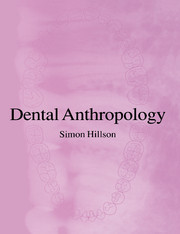Book contents
- Frontmatter
- Contents
- Acknowledgements
- Abbreviations
- 1 Introduction to dental anthropology
- 2 Dental anatomy
- 3 Variation in size and shape of teeth
- 4 Occlusion
- 5 Sequence and timing of dental growth
- 6 Dental enamel
- 7 Dentine
- 8 Dental cement
- 9 Histological methods of age determination
- 10 Biochemistry of dental tissues
- 11 Tooth wear and modification
- 12 Dental disease
- 13 Conclusion: current state, challenges and future developments in dental anthropology
- Appendix A: Field and laboratory methods
- Appendix B: Microscopy
- References
- Index
10 - Biochemistry of dental tissues
Published online by Cambridge University Press: 05 June 2012
- Frontmatter
- Contents
- Acknowledgements
- Abbreviations
- 1 Introduction to dental anthropology
- 2 Dental anatomy
- 3 Variation in size and shape of teeth
- 4 Occlusion
- 5 Sequence and timing of dental growth
- 6 Dental enamel
- 7 Dentine
- 8 Dental cement
- 9 Histological methods of age determination
- 10 Biochemistry of dental tissues
- 11 Tooth wear and modification
- 12 Dental disease
- 13 Conclusion: current state, challenges and future developments in dental anthropology
- Appendix A: Field and laboratory methods
- Appendix B: Microscopy
- References
- Index
Summary
Enamel, dentine and cement are all mineral/organic composites (Table 10.1). Mature enamel is almost entirely mineral, but dentine and cement are about one-quarter organic. Enamel close to the crown surface is more heavily mineralized than the inner enamel, which also has a higher carbonate concentration – factors which must make the inner layer of enamel less resistant to damage through percolation of ground water in buried material. The initial matrix of predentine and precement is entirely organic, whereas enamel matrix has crystallites seeded into it from the start (Table 10.1) and, protected in a bony crypt, may survive in some archaeological contexts.
The inorganic component
Calcium phosphate minerals
The inorganic component of living bone, cement, dentine and enamel is composed almost entirely of calcium phosphates from the apatite family of minerals, the bulk of it hydroxyapatite, a form that is not found outside mammalian tissues. Composition of apatites varies widely through substitutions and vacancies within the crystal lattice, and through adsorption of ions onto the surface (Table 10.2). The commonest substitutions are carbonate and fluorine, and the first crystallites of enamel matrix are particularly rich in magnesium and carbonate, forming the centre of the crystals which grow during the process of maturation (page 148). Solubility of apatites varies with composition, and increases when dental tissues are immersed in solutions of low pH, or in the presence of a calcium chelating agent such as EDTA (page 301).
- Type
- Chapter
- Information
- Dental Anthropology , pp. 217 - 230Publisher: Cambridge University PressPrint publication year: 1996
- 1
- Cited by



